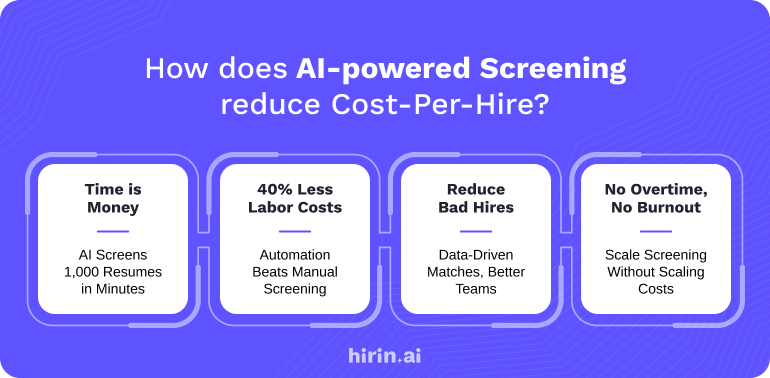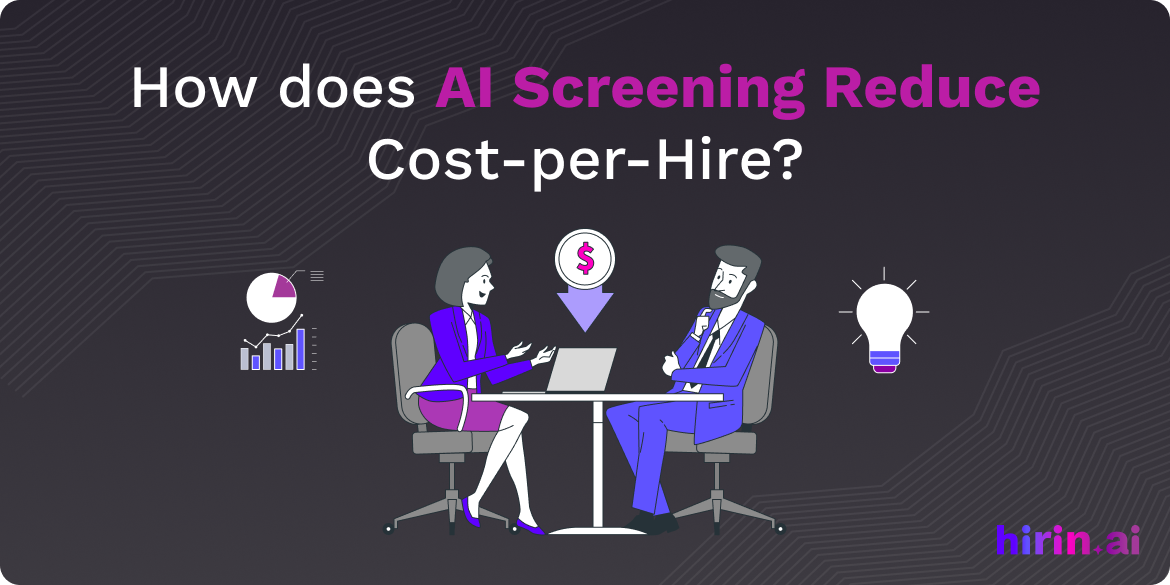Hiring is getting challenging. Companies are competing for talent. Open roles stay unfilled for weeks. Every extra day in the hiring cycle costs money. Manual screening is even slower and oftentimes frustrating.
Don’t know about hiring the right candidate, but with traditional hiring, your cost-per-hire definitely rises. And cost-per-hire isn’t just an HR metric. It’s a business risk. However, what if you could…
Slash screening time from hours to minutes?
Cut hiring costs by 30% or more?
Stop losing top candidates to slow processes?
You can achieve all the above and more with AI hiring software that automates candidate screening and interview management. AI-powered screening is the ultimate solution to hiring the right candidates faster and cost-effectively.
Besides, Artificial Intelligence works 24/7, never forgets, always adheres to hiring standards, and saves real money. That’s why prominent HR teams and staffing firms rely on AI screening.
We’re breaking down how AI screening reduces cost-per-hire and where the savings come from. So, stay tuned till the end to know why it’s the smart choice for building modern teams without spending your fortune.
How does AI screening differ from traditional screening methods?
Let’s start with how traditional screening works.
You post a job.
You get 100 resumes.
Now, someone -your recruiter or talent acquisition executive- must manually read through every single one. It’s slow. It’s repetitive.
And let’s be honest, after resume #30, you’re skimming.
In that case, you might miss great candidates. Or waste time on the wrong ones.
This is where AI candidate screening flips the game.
Instead of reading every resume line by line, AI hiring software parses them all in seconds. Beyond what ATS (Applicant Tracking System) does, AI looks for keywords, skills, job history, and patterns in hundreds of resumes at once.
You can think of it like a smart recruiting assistant who knows exactly what you’re looking for and scans at lightning speed.
| Task | Traditional Screening | AI Screening |
| Resume review | Manual, slow | Automated, instant |
| Candidate ranking | Based on gut feel | Based on data and job-fit scores |
| Bias risk | Medium to High | Reduced with consistent algorithms |
| Time per candidate | 5–10 mins | Under 10 seconds |
| Scale | Limited | High-volume ready |
Now, let’s understand it with an example,
Suppose you’re hiring a Python developer.
In the traditional method, you search resumes for the word “Python” and try to match the experience.
On the other hand, AI screening checks for relevant projects, stack mentions, GitHub links, and even NLP on job history, all in one go.
AI doesn’t just check if candidates have mentioned Python. It checks how they used it, where, and for how long and ranks them accordingly.
The best part is that artificial Intelligence learns and optimizes screening over time. If it sees you tend to pick candidates with certain patterns, it adjusts recommendations.

How Does AI-powered Screening Slash Costs Across the Hiring Funnel?
Hiring isn’t just expensive. It’s also full of hidden costs. Every step in hiring costs money. On the contrary, AI screening helps you cut those costs without cutting corners.
Let’s break it down where AI screening saves real money at every stage!
Faster Screening = Lower Time-to-Hire
Time is one of the biggest hiring expenses. Manual resume screening takes hours or days. Whereas AI screening tools scan 1,000 resumes in minutes.
For example, screening 300 resumes takes ~30 hours manually. AI cuts that to under 1 hour or less.
Consequently, you save 29 recruiter hours. That means if you pay recruiters $40/hour, that’s $1,160 saved per role. Now, calculate the same for all your open positions in total.
Less Manual Work = Lower Labor Costs
The manual screening is repetitive. Hiring teams spend 40–60% of their time on low-value tasks. Reading resumes. Filtering candidates. Scheduling interviews.
Choosing AI screening automates this grunt work. Meaning, you need fewer people or fewer hours. And fewer human recruiters or hours means saving on hourly rates and wages.
Smarter Matches = Fewer Bad Hires
A wrong hire is expensive. Lost time, productivity, and morale. According to U.S. Department of Labor, a bad hire can cost up to 30% of the employee’s first-year salary.
However, AI hiring software uses data-driven scoring to predict job fit. It considers skills, patterns, and past performance indicators. That’s how AI reduces the risk of wrong hires by matching candidates.
The AI screening recruiter doesn’t just ask, “Can they do the job?” It analyzes the potential and suggests whether they thrive here.
So, when you have better matches, you reduce mis-hires and save money wasted on re-hiring.
Fairer Screening = Higher Efficiency
Bias in hiring = missed talent = wasted time and money. Not to mention, it can lead to lawsuits, high attrition, and missed top talent.
Nevertheless, AI focuses on skills-first evaluation and experience, not names, schools, photos, or relations. So, with AI screening, you build stronger and biased-free teams of experts.
Need to screen 500 candidates tomorrow? AI won’t blink. No overtime. No extra hires. No burnout. Above all, whether you hire 5 or 500, your cost per screen stays flat. That’s what true scalability looks like.
How Do You Calculate the ROI of AI Screening?
Reviewing resumes can take 25 minutes to 21 hours, costing between $10.42 to $525.00. Additionally, preparing the shortlist of candidates costs an average of two hours and $62.50.
Hiring speed does matter. But what good if you have to employ tens of recruiters or spend on multiple software, job boards to source, ATS to screen, skill assessment, etc., to fill the position faster?
Even as a staffing firm, your budget will most likely go overboard! Consequently, the chances of generating a significant return on the investment you make in traditional hiring are low.
Nevertheless, AI in hiring gives you more return than you invest by automating screening resumes and candidates. Here’s how!
Reviewing each resume manually can take up to 10 minutes. That makes 17 hours to review 100 resumes. Whereas Artificial Intelligence can screen, score, and shortlist candidates for you in minutes.
Hence, the manual screening time of 16.66 hours is reduced to 1 hour with AI screening. At $40/hour, that’s $667 reduced to $40. Apply the same equation across all roles and calculate your savings.
Now, even if an AI screening tool costs $500/month, you will still see a significant ROI in addition to saving time-to-hire.
AI screening is the easiest way to stop burning cash on hiring!
Upon asking to choose the top three use cases of AI in recruitment, hiring team members reported,
58.9% of hiring team members prefer using AI for resume screening,
43.1% use AI for candidate matching,
37.6% prefer AI interview scheduling.
Every minute your recruiters spend manually screening resumes is money leaking from your budget. AI screening plugs that leak. It chops the recruiter’s workload, kills wrong hires, and speeds up hiring. All while saving thousands.
Imagine reducing a $2,000 screening cost to just a few dollars. Your recruitment budget stretches further. Smarter hires mean lower turnover and faster onboarding.
So, why wait and watch your most potential candidates get hired by your competitors?
Invest in AI and see real ROI!
